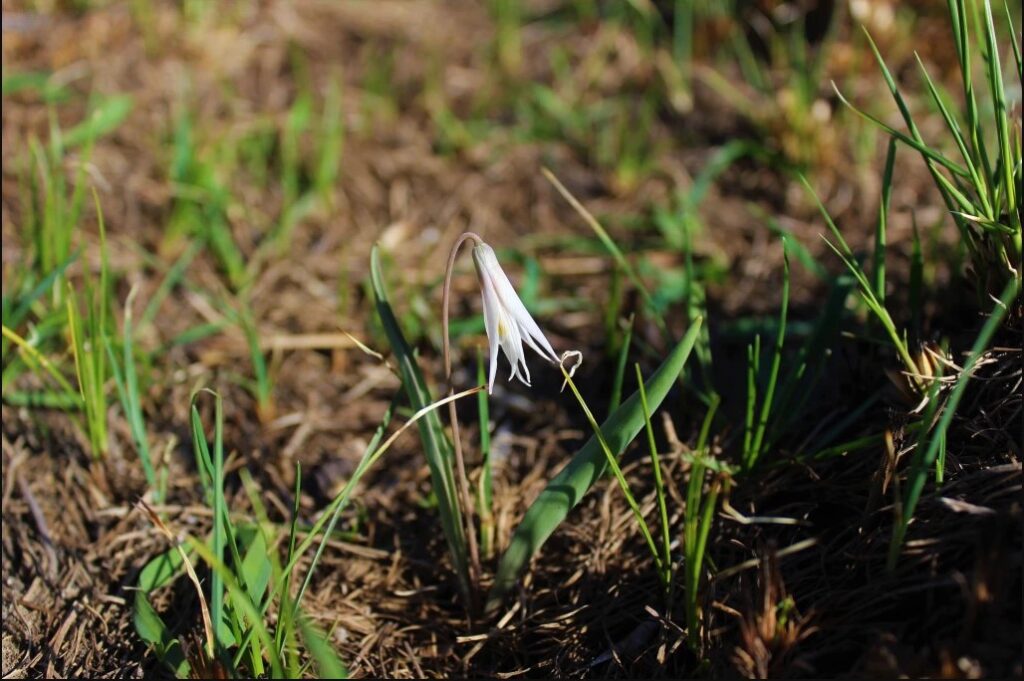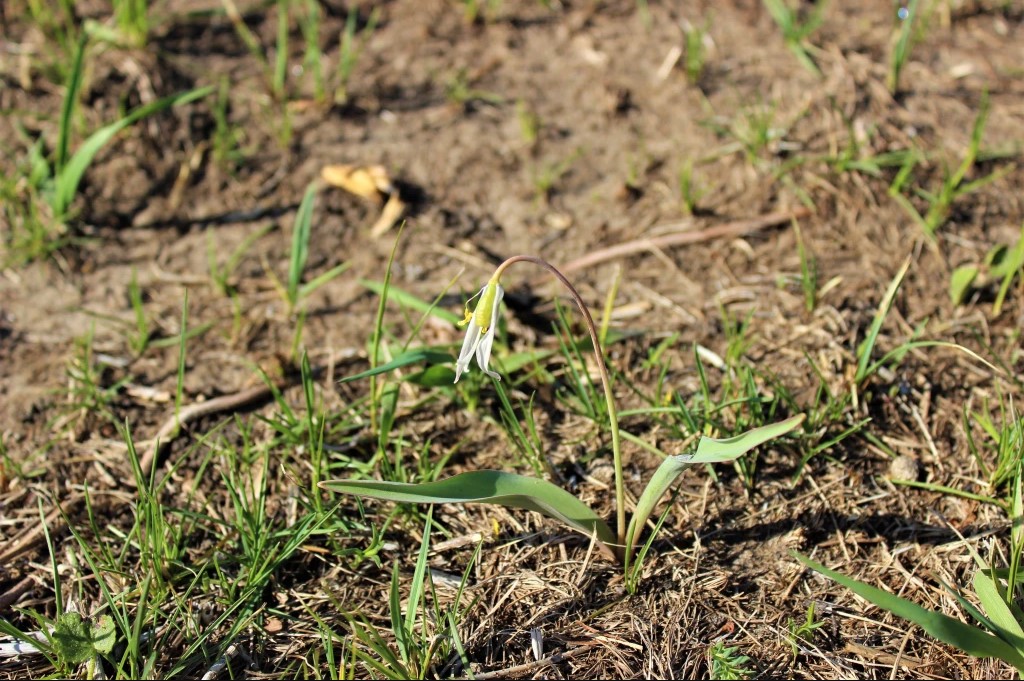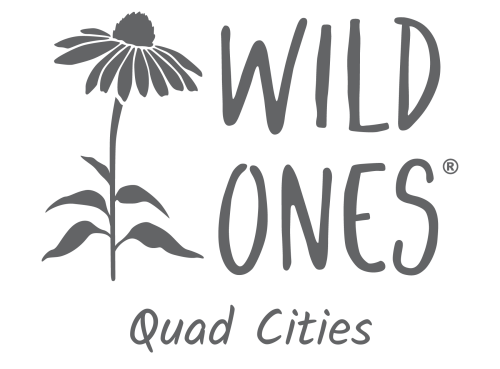written by Grant Fessler, originally published on his website, gcology.net

With a sudden burst of unseasonably warm weather this past week, the spring ephemerals have leapt into blooming here in the Quad Cities region. Our remnant woodlands are now teaming with whites, purples, blues, and yellows, and the early spring pollinators are hard at work. Bumblebee (Bombus) queens and mining bees (Andrena) have awoken from their winter dens, and the first red admirals (Vanessa atlanta), eastern commas (Polygonia comma), and spring azures (Celastrina ladon) are now in flight. In addition to all the hustle and bustle in the woods, the very first signs of color are now beginning to show in the prairies.
Recently, my friend Sam and I were informed by an expert botanist of the location of one of Illinois’ rarest and earliest prairie wildflowers — Erythronium mesochoreum, the prairie trout lily. He said that they were up and already blooming! We quickly set a time to go visit.
April 14th, 2023
It was a hot early spring day, and the sky was cloudless. My car’s thermometer read 82 degrees (oof!) as I drove down a two-lane county highway in rural Whiteside County, Illinois. The sun beat down on the barren soil of the crop fields as I imagined what the landscape must’ve looked like 200 years ago when it was covered by the vast aboriginal prairies, savannas, and wetlands.
I arrived at the site (the identify of which I feel obligated to omit due to the conservation concerns of this species) and parked on the side of a gravel road near a large open-grown oak. Soon Sam joined me. We were at one of the few types of places where the original Illinois prairie has survived — a pioneer cemetery. Some of these cemeteries were never plowed, only mowed or hayed, and thus, the flora has remained more or less intact. This particular cemetery protected approximately one acre of sand prairie, a unique type of prairie largely restricted to the Mississippi, Rock, and Illinois river valleys in Illinois.
With our eyes focused on the ground, we eagerly searched for small, white flowers amongst the dry remains of last year’s vegetation. Ah-ha! we spotted a blooming plant in the mowed lawn of the cemetery.

Upon closer inspection, we were greeted by the bright flowers of cleft phlox (Phlox bifida). Although this wasn’t the trout lily, we were happy to find it, as it was the first time either of us had met this species! The flowers had a sweet, gentle, and intoxicating aroma, the kind which lifts the spirits and momentarily releases one from their day-to-day worries. Many clumps of phlox grew in the lawn, seemingly benefitting from the regular disturbance.
We continued our search, now heading towards an area of the sand prairie which was burned last fall. We walked amongst dry stems of little bluestem (Schizachyrium scoparium), leadplant (Amorpha canescens), dropseed (Sporobolus sp.), and prairie rose (Rosa sp.). As we reached the bare ground of the burned area, something small and white quickly caught my eye. It was the prairie trout lily!


Before we knew it we were standing amongst several hundred trout lilies! Some had already gone to seed, others were dropping their tepals, having been pollinated, and yet others were still in bloom. What a euphoric moment! Being in the presence of these prairie treasures was a memory I will surely never forget.

You may be wondering, however, if is this the same white trout lily (Erythronium albidum) that is common in our woodlands. Although the two species are very similar at first glance, they are considered separate for several reasons:
- The leaves of E. mesochoreum are consistently folded along their length (conduplicate) and generally lack mottling (see above photos) vs. the more or less flat and mottled leaves of E. albidum.
- E. mesochoreum tends to have tepals that are, at most, spreading vs. tepals that are usually sharply bent upwards (reflexed) in E. albidum (see photo below).
- E. mesochoreum does not usually form dense colonies like E. albidum does. Those who have payed close attention to E. albidum may recall how it can carpet the forest floor with sterile leaves while producing relatively few flowering stems (see photo below).
- The final character that splits the two, at least here in Illinois, is that E. mesochoreum is strongly associated with dry prairies where as E. albidum is almost exclusively a woodland species.

The ranges of the two species are also very different (see maps below). Note that prairie trout lily is only known from a small handful of counties in Illinois and is very rare. There is one other species of Erythronium present in Illinois called yellow trout lily (E. americanum). It is easily distinguished from the other two by its yellow flowers, and it is generally restricted to the eastern half of Illinois.

and http://bonap.net/MapGallery/County/Erythronium%20albidum.png
Jumping back to our time at the cemetery prairie…
Sam and I spent the next hour or so exploring the prairie before heading our separate ways. It was quite the honor to start getting to know that fragment of original Illinois. I will definitely be returning later in the season to see what other secrets she is willing to share.
References
- Illinois Natural History Survey. Erythronium mesochoreum White trout lily. Illinois Natural History Survey Plantdb. (n.d.). Retrieved April 15, 2023, from https://wwv.inhs.illinois.edu/data/plantdb/detail/3082
- Kaul, Robert B., The Status of Erythronium albidum and E. mesochoreum (Liliaceae) in Nebraska. (1989). Transactions of the Nebraska Academy of Sciences and Affiliated Societies. 172. https://digitalcommons.unl.edu/tnas/172
- Mohlenbrock, R. H. (2014). Vascular Flora of Illinois: A field guide. Southern Illinois University Press.
- MissouriPlants.com. Erythronium mesochoreum knerr. Missouri Plants. (n.d.). Retrieved April 15, 2023, from https://www.missouriplants.com/Erythronium_mesochoreum_page.html
- NatureServe. Erythronium mesochoreum Midland Fawnlily. NatureServe Explorer 2.0. (2023, April 7). Retrieved April 15, 2023, from https://explorer.natureserve.org/Taxon/ELEMENT_GLOBAL.2.159267/Erythronium_mesochoreum
For more resources and stories on the flora of the Quad Cities Region, visit Grant’s website gcology.net
